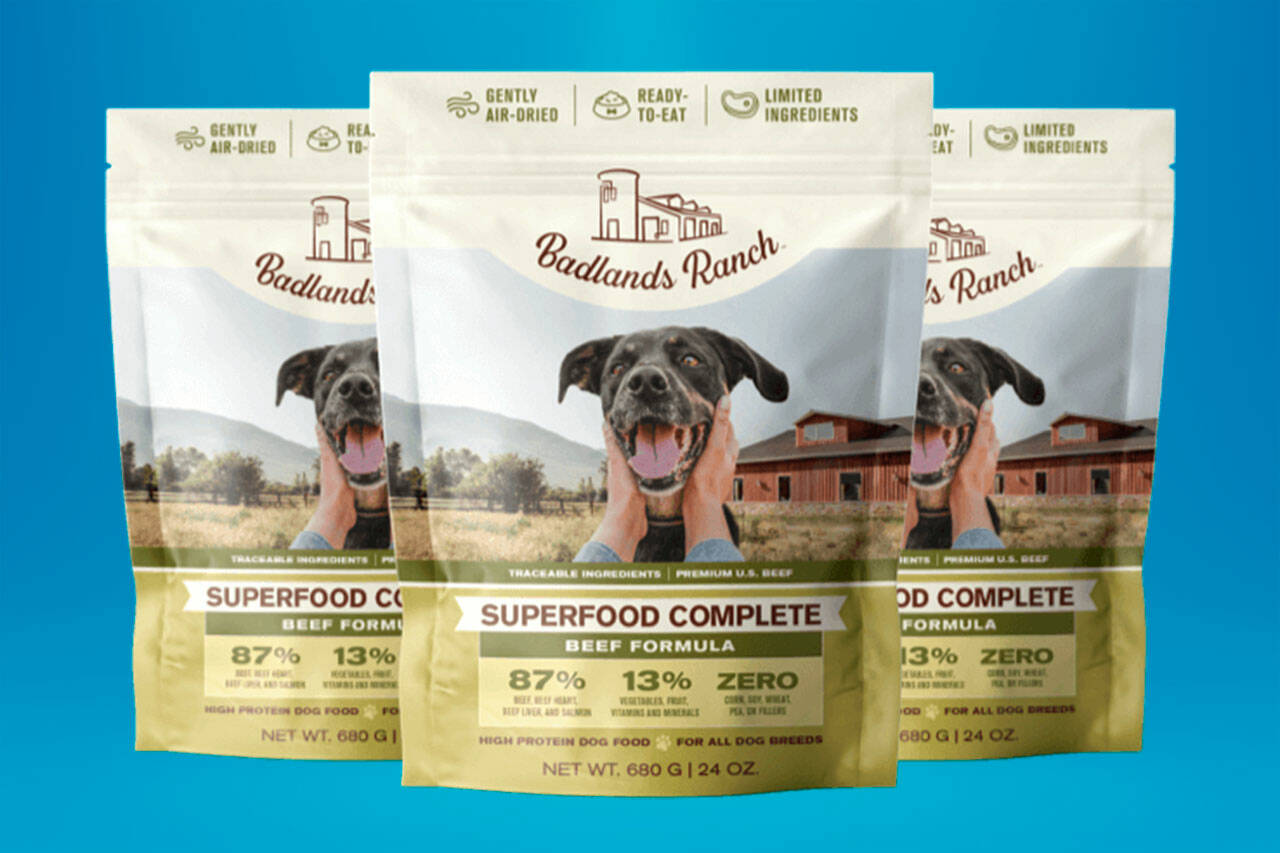Badland Ranch Canine Meals embarks on a venture to supply canines with the nourishment they deserve, providing a healthy and balanced nutrition that caters to their particular wishes. With a dedication to the use of herbal components and adhering to the best requirements of high quality, Badland Ranch Canine Meals stands proud as a depended on selection for canine house owners in quest of optimum diet for his or her hairy buddies.
Uncover the original mix of components, the various product line, and the unwavering determination to buyer pleasure that units Badland Ranch Canine Meals aside within the dog food trade.
Elements and Dietary Worth
Badland Ranch Canine Meals is crafted with a mix of top rate components, in moderation decided on to supply optimum diet in your dog significant other. Every component serves a selected goal, contributing to the entire well being and well-being of your canine.
The root of Badland Ranch Canine Meals is actual, lean protein, sourced from top quality hen and lamb. This protein supplies crucial amino acids, essential for construction and keeping up muscular tissues, supporting tissue restore, and fueling your canine’s calories ranges.
Carbohydrates, Badland ranch pet food
For sustained calories and digestive well being, Badland Ranch Canine Meals contains a mix of advanced carbohydrates, together with brown rice, oatmeal, and barley. Those carbohydrates are slowly digested, offering a gradual unlock of glucose into the bloodstream, combating calories spikes and crashes.
Fat
Very important for calories garage, hormone manufacturing, and pores and skin and coat well being, Badland Ranch Canine Meals features a steadiness of wholesome fat from hen fats and flaxseed. Those fat supply omega-3 and omega-6 fatty acids, supporting cognitive serve as, decreasing irritation, and selling a glittery, wholesome coat.
Nutrients and Minerals
To make sure a whole and balanced nutrition, Badland Ranch Canine Meals is fortified with a complete mix of crucial nutrients and minerals. Those come with calcium for sturdy bones and enamel, diet A for wholesome imaginative and prescient, and antioxidants to enhance the immune gadget.
Distinctive Elements
Atmosphere Badland Ranch Canine Meals excluding competition is the inclusion of distinctive and really useful components. Yucca schidigera extract, a herbal prebiotic, helps digestive well being and decreases stool scent. Glucosamine and chondroitin sulfate, naturally happening compounds, advertise joint well being and mobility.
Product Line and Permutations
Badland Ranch Canine Meals gives a complete vary of product traces and diversifications adapted to fulfill the precise wishes of canines at other ages, breeds, and job ranges.
Every product is meticulously formulated with top quality components to make sure optimum diet and well-being in your dog significant other.
Age-Primarily based Permutations
- Pet Method:Designed for doggies as much as three hundred and sixty five days of age, this formulation helps wholesome expansion and construction.
- Grownup Method:Appropriate for canines over three hundred and sixty five days outdated, this formulation maintains optimum well being and energy.
- Senior Method:Specifically formulated for senior canines over 7 years of age, this formulation addresses the original dietary necessities of ageing canines.
Breed-Primarily based Permutations
- Huge Breed Method:Catered to the precise dietary wishes of enormous breeds, this formulation helps joint well being and mobility.
- Small Breed Method:Designed for small breeds, this formulation supplies a balanced nutrition with smaller kibble measurement for more uncomplicated intake.
Task Degree Permutations
- Lively Method:Perfect for extremely lively canines, this formulation supplies further calories and helps muscle restoration.
- Much less Lively Method:Formulated for much less lively canines, this formulation is helping deal with a wholesome weight and save you weight problems.
Sourcing and Production

Badland Ranch Canine Meals takes satisfaction in sourcing top quality components from respected providers. Our crew of mavens in moderation selects every component to make sure that it meets our stringent requirements for protection, dietary worth, and sustainability.
The producing procedure is performed in cutting-edge amenities that adhere to the best protection and high quality requirements. Every batch of Badland Ranch Canine Meals undergoes rigorous checking out to make sure consistency and compliance with our strict high quality keep watch over protocols.
Certifications and Accreditations
Badland Ranch Canine Meals is proud to have won a lot of certifications and accreditations that attest to our dedication to high quality and protection.
- American Feed Keep watch over Officers (AAFCO) certification
- Nationwide Animal Complement Council (NASC) Excellent Production Practices (GMP) certification
- ISO 9001:2015 certification for our high quality control gadget
Buyer Opinions and Comments
Badland Ranch Canine Meals has garnered a great deal of buyer evaluations and comments, each certain and adverse. Those evaluations supply treasured insights into the strengths and weaknesses of the product, in addition to the studies of canine house owners who’ve used it.
Not unusual certain issues within the comments come with the prime quality of the components, the noticeable development in canines’ well being and effort ranges, and the very good customer support supplied through Badland Ranch.
Adverse Comments
Adverse comments essentially makes a speciality of the excessive value of the product and the occasional digestive problems skilled through some canines. Badland Ranch has addressed those issues through providing a pleasure ensure and offering detailed feeding pointers to reduce the chance of digestive issues.
Corporate’s Reaction to Comments
Badland Ranch takes buyer comments significantly and actively seeks to strengthen its services and products in accordance with this comments. The corporate ceaselessly evaluations buyer evaluations and makes changes to its formulations, packaging, and buyer enhance to handle any issues raised through its consumers.
Advertising and marketing and Promoting
Badland Ranch Canine Meals employs a multifaceted advertising and promoting technique to succeed in its audience and determine a robust emblem presence. The logo leverages a mix of conventional and virtual channels to hook up with puppy house owners and advertise its merchandise.
Logo Positioning and Differentiation
Badland Ranch positions itself as a top rate pet food emblem that prioritizes the well being and well-being of canines. The logo emphasizes the usage of top quality, herbal components and a focal point on dog diet. To tell apart itself from competition, Badland Ranch highlights its dedication to sustainable practices, together with accountable sourcing and eco-friendly packaging.
Advertising and marketing Campaigns and Effectiveness
Badland Ranch has introduced a number of a hit advertising campaigns that experience considerably larger emblem consciousness and gross sales. The logo’s promoting efforts have featured memorable slogans, enticing visuals, and a constant emblem message. Badland Ranch has additionally partnered with puppy influencers and veterinarians to advertise its merchandise and supply skilled endorsements.
The effectiveness of those campaigns is obvious within the rising buyer base and certain comments from puppy house owners.
Pricing and Worth: Badland Ranch Canine Meals

Badland Ranch Canine Meals positions itself as a top rate pet food emblem, with its pricing reflecting the standard of its components and the worth it gives to canine house owners.
In comparison to identical merchandise out there, Badland Ranch Canine Meals falls inside the mid-to-high value vary. Then again, the corporate justifies its value level through emphasizing the usage of top quality, ethically sourced components, in addition to its dedication to sustainable practices.
Reductions, Promotions, and Loyalty Techniques
Badland Ranch Canine Meals gives quite a lot of reductions and promotions to make its merchandise extra obtainable to canine house owners. Those come with:
- Subscribe and save systems that supply reductions on routine orders.
- Seasonal promotions and vacation gross sales.
- Loyalty systems that praise repeat consumers with issues or reductions.
Packaging and Design
Badland Ranch Canine Meals merchandise are available in visually interesting and practical packaging designed to offer protection to the meals and deal with its freshness.
The packaging is composed of a resealable plastic bag with a sturdy external that forestalls moisture and air from coming into. The bag may be puncture-resistant, making sure the meals remains intact all through dealing with and transportation.
Visible Attraction and Branding
The packaging includes a placing design that captures the rugged spirit of the Badland Ranch emblem. The brand, that includes a silhouette of a canine in opposition to a backdrop of rolling hills, is prominently displayed at the entrance of the bag. The packaging additionally comprises colourful colours and attention-grabbing graphics that make it stand out on retail cabinets.
The branding parts at the packaging obviously keep in touch the product’s key promoting issues, corresponding to its herbal components, top quality protein assets, and grain-free formulation. The packaging additionally features a clear window that permits shoppers to peer the real product ahead of buying.
Sustainability and Environmental Have an effect on

Badland Ranch Canine Meals prioritizes sustainability right through its operations. The corporate employs moral sourcing practices, reduces its environmental affect thru accountable packaging and production processes, and has won reputation for its sustainability efforts.
Sourcing and Production
Badland Ranch assets its components from native and sustainable farms. The corporate guarantees that its providers adhere to strict environmental requirements, minimizing the carbon footprint related to transportation and selling animal welfare. Moreover, the producing amenities make the most of energy-efficient applied sciences and enforce waste relief projects.
Packaging and Distribution
Badland Ranch makes use of eco-friendly packaging fabrics, corresponding to biodegradable and recyclable cardboard, to reduce waste. The corporate additionally optimizes its distribution community to scale back gas intake and emissions.
Certifications and Popularity
Badland Ranch Canine Meals has won certifications from unbiased organizations for its sustainability practices. Those come with the Sustainable Agriculture Community (SAN) certification and the Environmental Coverage Company’s (EPA) Inexperienced Energy Partnership certification.
FAQ Useful resource
What units Badland Ranch Canine Meals excluding different manufacturers?
Badland Ranch Canine Meals distinguishes itself thru its unwavering dedication to the use of herbal components, prioritizing the well-being of canines. The absence of synthetic flavors, colours, and preservatives guarantees that your hairy good friend receives handiest the purest and maximum healthy diet.
How does Badland Ranch Canine Meals cater to other canines’ wishes?
Badland Ranch Canine Meals understands that each canine is exclusive, which is why it gives a various product line adapted to express wishes. Whether or not your canine is a pet, an grownup, or a senior, there is a formulation designed to give you the optimum steadiness of vitamins for his or her age and job stage.
The place can I in finding Badland Ranch Canine Meals?
Badland Ranch Canine Meals is broadly to be had at puppy provide retail outlets and on-line shops. You’ll additionally consult with the Badland Ranch site to find a shop close to you or acquire immediately from the supply.

